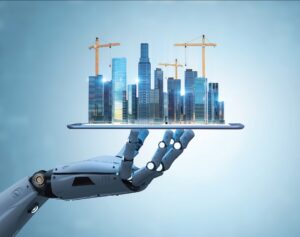
Early analysis of AI’s potential to transform architecture points to its role as a collaborative tool that designers can use to revise projects at accelerated timelines. iStock illustration
Time is money, and finding ways to cut down on lengthy design, development and building timelines can keep projects financially feasible.
Is artificial intelligence, or AI, the wonder drug for commercial projects in a costly market like Massachusetts?
Don’t load those silver bullets quite yet. Commercial real estate isn’t exactly an industry known as a forerunner of tech innovation.
But there are plenty of experts in the development and design orbits who say AI can deliver a slew of benefits, from planning and review efficiency to tackling sustainability.
“The industry has not necessarily always been very bullish or open to innovation or adoption or even just melding elements of creativity as it relates to how it operates,” said Nadine Ezzie, a commercial real estate attorney and the founder and president of real estate advisory firm Ezzie + Co. “What I think is so incredibly exciting about artificial intelligence is that it has the ability to truly transform the way that we do business, not only on the front side with occupiers or tenants or whatever that might be, but also with how we design, how we construct and how we conduct our operations internally.”
The lowest-hanging fruit for AI appears to be in the pre-construction phase. A report on 2024 design trends to watch from architecture firm Gensler highlights AI as a collaboration tool designers can use to rapidly tweak projects and come up with new iterations with far more rapid response times than today.
Further, its predictive analysis capabilities can be instrumental in the vision and preliminary design process.
“The ability to map that out and understand a preliminary design concept can make the rest of the process a lot smoother. It can allow the entire project team – consultants, contractors, larger client teams – to integrate earlier on,” said Jared Krieger, principal and co-managing director of Gensler Boston. “Because of its powerful pattern recognition and ability to speed discovery, streamline outputs, and provide new insights, AI has the capability to make the design and development process more efficient.”
Revising Project Proposals in Real Time
Those days of lengthy back-and-forth review processes that require going back to the drawing board to come up with refreshed designs based around community input? AI won’t obliterate the need for community review, but it can certainly speed up the response time to their concerns.
Imagine being able to see design changes in real time at a planning and review meeting instead of having to wait for weeks until the next gathering.
“People are always operating in very siloed ways, and that has something to do in part with the tools that they’ve been using and it also has something to do in part with the culture and attitudes,” Ezzie said. “It hasn’t necessarily always been a collaborative environment in certain areas where it should be.”
The predictive analysis from AI can assist in sustainability efforts in the development community, especially when it comes to building operations. Gensler’s Blox, a proprietary algorithm-powered design tool, links to the firm’s tools that study embodied and operational carbon.
“For example, in considering building operations, we can input variables—such as local climate data on any given day and energy consumption – into AI algorithms to help generate concepts that prioritize energy efficiency and sustainability,” Krieger said.
Potential to Optimize Preventive Maintenance
Optimizing energy usage and reducing waste are the leading ways AI is helping boost sustainability in the development orbit today. It can also help anticipate mechanical failures, thereby keeping maintenance costs at a minimum.
But AI isn’t going to completely upend the design and development process. Think of it more as a collaborative tool instead of some type of mass eliminator of jobs or the community review process.
“The entitlement process still requires community engagement and government oversight,” said James Scott, a lecturer and research scientist at the MIT Center for Real Estate’s Real Estate Technology Hub. “Can AI help with making this process faster and more efficient? Ultimately it is hoped that it can showcase all of the optimal designs from an efficiency and aesthetic perspective. However, the process will still require human verification, while at the same time needing to layer in the economic consequences for a locality in order to help community members and public officials make the best decisions.”
There are limitations to what AI can produce. Cost analysis remains a shortcoming today, Scott said, amid the volatile construction pricing climate. There will still be a need for review on what AI might recommend for a project – and how feasible the financials and engineering actually are.
“One of the most incredible aspects of this world is that we all have different tastes and perspectives, and understanding of beauty and design, and differing opinions on what is best for a community at a specific moment in time,” Scott said. “These things can be very subjective, and they’re not necessarily the same answers that come out at the end of an equation or an algorithm, but maybe through AI we can help better understand what are the optimal scenarios for the greatest amount of people in a community, making our cities better places to live for all of us.”





